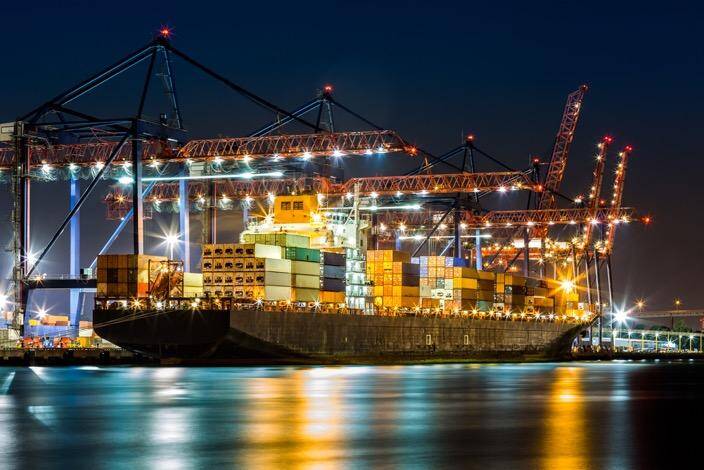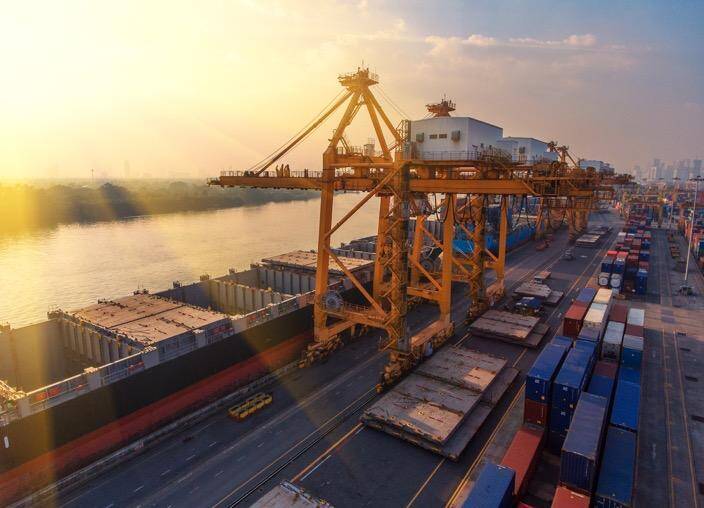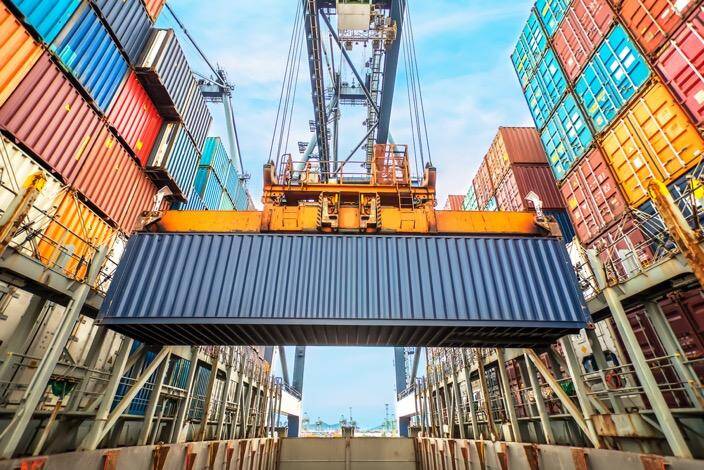Modern shipping using containers makes it possible to ship massive quantities of goods around the globe in a consistent and standardized manner. Over the past six decades, containerization has become the most common method of shipping goods. In fact, more than 60% of goods shipped by sea are sent in containers.
Despite how common this method of shipping is, containerization still is not widely understood by many people. What is containerization and how did it begin? Let’s take a look at the history of containerization to find out.

What Is Containerization?
According to Merriam-Webster, containerization is “a shipping method in which a large amount of material (such as merchandise) is packaged into large standardized containers. Developed in the 20th century, it is a vital cargo-moving technique that allows shippers to transport large quantities of goods quickly and efficiently. Containers are often transported from factories by truck and are then transferred to railroad cars. The railroad car then delivers the container to a ship and, finally, a barge for international transport. This technique makes transferring cargo easier and significantly less costly.
How Did Containerization Begin?
The idea of using some type of container when shipping goods is not a new one. Custom corrugated boxes with similarities to modern containers were used in horse-drawn and rail transport in England since as early as 1792. In the United States, the government utilized small standard-sized containers to transport supplies during World War II. It wasn’t until 1955, however, that modern containerization was born.
A North Carolina trucker named Malcolm P. McLean purchased a steamship company in this year with the idea of shipping truck trailers still loaded with their cargo. He quickly discovered that it would be much more efficient to have a standardized container that could be transferred from a truck directly onto a ship.
McLean’s theory was based on the idea that efficiency in shipping could be greatly improved through a system of “intermodalism.” Intermodalism is a system in which efficiency is improved when the same container, containing the same cargo, can be shipped via different transport modes with minimal interruption.
This theory proved to be correct. McLean created a big container that could be moved seamlessly between trucks, railcars and ships. This revolutionized the entire logistical process and changed the international trade industry dramatically. Containerization proved to be a huge success and made global trade more possible and efficient than ever before.

Intermodalism
Because the birth of containerization was inspired by intermodalism, it is important to understand exactly what intermodalism it. It involves the organization of several models of transportation between a point of origin and the final destination. It also includes transfers between modes. The main goal of intermodalism is to link transportation systems together that could not otherwise be connected. In the logistics industry, it often involves containers leaving manufacturing facilities by truck and then being carried by rail to a port where it can be loaded onto a container ship.
Prior to containerization, shipping containers came in an infinite number of sizes and shapes. This made it impossible to transfer them between varying modes of transportation in a quick, efficient manner. By designing larger containers with just two standard sizes, McLean created a way of quickly transferring cargo from one type of carrier to another.
The First International Container Shipment
On April 26, 1956, the first container ship departed on its maiden voyage. The converted tanker Ideal X departed from Newark, New Jersey with 58 fully loaded truck trailers and set sail for Houston. It wasn’t until almost exactly 10 years later that the first international container shipment set sail.
By 1960, several shipping companies had adopted containerization for domestic transport. On April 23, 1966, Sea-Land’s Fairland container ship departed New Jersey for The Netherlands with 236 containers on board. This trip marked the first transatlantic voyage for McLean’s company’s commercial line connecting New York and Northern Europe. With this voyage, global trade became much more affordable, efficient and common.
The success of Sea-Land’s transatlantic service spurred major competition, and within a few years, many companies had joined the transatlantic container shipping industry. While most focused on US-Europe trading, Matson introduced container shipping for Pacific trade. By the fall of 1967, the first fully containerized freight service between the Far East and the West Coast of the United States was born.

Modern Container Shipping
Today, approximately 90% of global cargo is transported by container. The average cost of shipping a product internationally has fallen from roughly 15% of the retail price to less than 1%. Containerization has decreased cargo and theft while allowing international shipments to make it to their final destinations faster than ever before.
Containerization spurred global trade and has made sourcing goods from other countries fast, affordable, and efficient. There are some downsides, though. While ports currently handle more cargo than ever before, there are fewer jobs for dockworkers since it only takes one person to operate a crane capable of moving numerous containers in a matter of minutes. Low-cost goods from other countries have also led to the loss of numerous jobs in developed countries that once manufactured their own goods.
Over the course of just six decades, McLean’s invention of containerization completely changed the logistics industry. While there are some drawbacks, his vision helped make the world a little bit smaller by enabling efficient trade on a global scale.

Ingrid Maldine is a business writer, editor and management consultant with extensive experience writing and consulting for both start-ups and long established companies. She has ten years management and leadership experience gained at BSkyB in London and Viva Travel Guides in Quito, Ecuador, giving her a depth of insight into innovation in international business. With an MBA from the University of Hull and many years of experience running her own business consultancy, Ingrid’s background allows her to connect with a diverse range of clients, including cutting edge technology and web-based start-ups but also multinationals in need of assistance. Ingrid has played a defining role in shaping organizational strategy for a wide range of different organizations, including for-profit, NGOs and charities. Ingrid has also served on the Board of Directors for the South American Explorers Club in Quito, Ecuador.







































